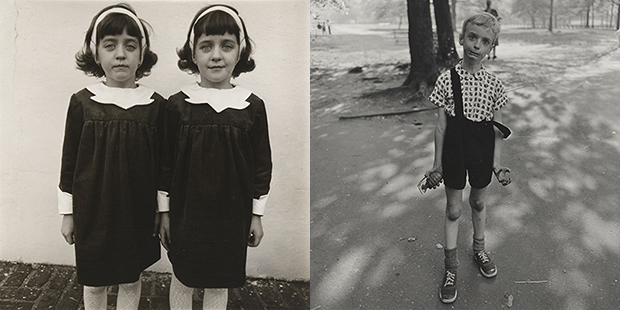 Best known for her intimate black-and-white portraits, Heide Museum of Modern Art presents the National Gallery of Australia’s touring exhibition, Diane Arbus: American Portraits from 21 March 2018.
Best known for her intimate black-and-white portraits, Heide Museum of Modern Art presents the National Gallery of Australia’s touring exhibition, Diane Arbus: American Portraits from 21 March 2018.
The photographs of Diane Arbus (1923-71) are among the most widely recognised in the history of photography. Her images stand as powerful allegories of post-war America, and once seen are rarely forgotten. Works such as Identical twins, Roselle, N.J., 1966 (pictured left) and Child with toy hand grenade, in Central Park, New York City (pictured right) have been described as two of ‘the most celebrated images in the history of the medium’.
Featuring 35 of Arbus’s most iconic and confrontational images from 1961–71, this exhibition examines the last decade of Arbus’s life, the period in which her style is in full flight. Her work has polarised viewers who question whether she exploited or empowered her subjects, who were often drawn from society’s margins.
“The National Gallery of Australia is privileged to hold such an extraordinary collection of work by a photographer of Arbus’s significance,’ said Curator Anne O’Hehir. “This collection covers Arbus’s best-known pictures, and also includes images which are rarely seen. This exhibition is a testament to the power of Arbus’s extraordinary vision.”
Diane Arbus was born Diane Nemerov, the daughter of wealthy Jewish New Yorkers; her father ran Russek’s, a department store on Fifth Avenue selling furs and women’s clothing. Growing up in an apartment in a towering building on Central Park West, her world was highly protected, one in which she never felt adversity.
This was something Arbus resented both at the time and later; it seemed to her to be an unreal experience of the world. At 18 she married her childhood sweetheart, Allan Arbus, and for a decade from the mid 1940s, they ran a successful photography studio doing fashion shots for leading picture magazines.
In 1956 Arbus ceased working with Allan in the studio and began instead to explore subjects of her own choice. She was, apart from the occasional class, essentially self-taught and as she struck out on her own, undertaking a detailed study of the work of other photographers.
Compelled to confront that which had been off-limits in her own privileged childhood, she looked to other photographers who had confronted the world head-on, including Weegee, William Klein, Walker Evans and Lisette Model. They recorded, each in their own way, their surroundings with an at-times frightening candour. In their images, Arbus found an uncompromising view of the world, stripped of sentimentality.
“Heide is delighted to present this exhibition of the renowned photographer Diane Arbus,” said Heide Director & CEO, Dr Natasha Cica. “Her uncompromising view challenged existing photography conventions in a surprising and enchanting way.”
Arbus’s photographs are exhibited alongside a selection of works by other leading American photographers whose work influenced Arbus, was shown alongside hers in the ‘60s, or has been influenced by her. These include famous images by Lisette Model, Walker Evans and Weegee, her contemporaries William Klein, Garry Winogrand, Lee Friedlander and Milton Rogovin as well as a slightly younger generation, work by Mary Ellen Mark and William Eggleston.
Diane Arbus: American Portraits
Heide Museum of Modern Art, 7 Templestowe Road, Bulleen
Exhibition: 21 March – 17 June 2018
Entry included with Museum Pass
For more information, visit: www.heide.com.au for details.
Image: Diane Arbus, Identical twins, Roselle, N.J., 1966. gelatin silver photograph. National Gallery of Australia, Canberra. Purchased 1980 / Child with toy hand grenade, in Central Park, New York City, 1962. gelatin silver photograph. National Gallery of Australia, Canberra. Purchased 1980
